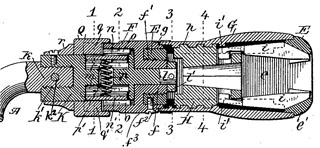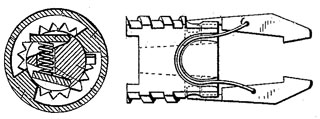|
You |
     The patent encompasses a fancy wrist-handle mechanism (not shown in my abridgement of the official drawings above) which did not find its way into the production model. The pad may contain the retention mechanism in the patent, but I have not yet disassembled it. The jaws in the brace's chuck do not match the patent; I have not found any patent to match the chuck design of this brace. The sliding block in this brace is spring-biased towards the front and contains a receptacle for a square tanged bit. The jaws, mounted in the spindle, merely grip the straight portion of the shaft of the bit. The effect is that of a quick-release mechanism. The patent's jaws are mounted in another moving block, which is oriented 90 degrees differently to the moving block in the brace. |